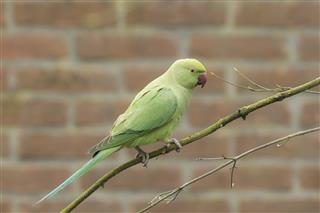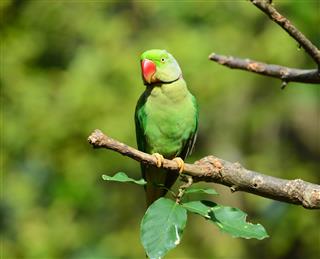
Remarkably known for their red beak and colorful neckband, the Indian ringneck parakeets are excellent choices for keeping as pets. Proper training is required to make these speaking Indian ringneck parrots gentle and loyal to their owners. To know more about them, read on.
While naming some of the wonderful birds for rearing, the ringneck parakeets always lead the list. They not only look amazing, but these adorable birds are intelligent too. They are basically of two types, based on the origin, viz. the Indian ringneck parakeets and the African ringneck parakeets. They differ in the body buildup and mandible color. The Indian ringnecks have a more compact body and their upper mandible is bright red, which is otherwise brownish red in case of African ringneck parakeets.
Facts and Information
The Indian ringneck parakeets are scientifically represented by the name Psittacula krameri manillensis in honor of Wilhelm Heinrich Kramer, an Austrian naturalist. They are known by other common names – Indian ringneck parrots, rose-ringed parakeets and simply Indian ringnecks. These birds have a slightly slender, moderate sized body adorned with an exceptionally long tail. If you are interested in keeping these lovely birds as pets, the following info on Indian ringnecks will interest you.
Notable Features
The Indian ringnecks sport a green or teal colored body. Along with the tail, they measure approximately 16 inches (40 cm) in length. Upon expansion, the length of a single wing is 5.9 inches or more. You can identify the male parakeet from the distinctive black neck-ring and pink colored band in the nape. The hooked beak with bright red upper mandible is another pronounced attribute of rose-ringed parakeets.
Sexual Dimorphism
Like other types of parakeets, sexual dimorphism is obvious in case of these parakeets. The unique neck ring is absent in the female parakeets. When observed carefully, you will notice a mildly dark-colored band in the neck region of females. Also, they do not have those distinct blackish spots on the face, which are seen in the male counterparts.
Diet and Feeding
Their routine diet comprises different types of fruits, vegetables, berries, seeds and nuts. For feeding captive birds, it is of utmost importance to give a balanced amount of all these food options, which is not so easy. A better way is to purchase food pellets sold in pet centers, which are specially formulated for ringneck parakeets. Needless to mention, regular cleaning of the food and water bowls is a necessity.
Indian Ringnecks as Pets
One aspect that interests bird lovers is, both the male and female Indian ringneck parrots can mimic human speech. They are extremely sporty and expect quality time as well as special attention from the owner’s side. Some pet owners have a different opinion about keeping them as pets, and state that they are very difficult to tame. Proper training is all you need for keeping these birds as pets.
Temperament
The Indian ringneck parakeets temperament has been a much talked about topic amongst bird enthusiasts. After about 1½ years, they may become moody, which indicates sexual maturity. But, there is no denying the fact that they make great pets. When left on their own, they tend to get bored very soon. This is when they become aggressive, and start biting and chewing anything that comes in their way.
Breeding Approaches
Breeding of rose-ringed parakeets is proceeded to develop improved lines, specially in terms of color. Besides the typical green color, they are now available in shades of blue, white and yellow. Controlled breeding makes it possible to create vibrant colored hybrids. Thus, you can pick your favorite parakeets and rear in them appropriate cages. Give proper care to parakeets, as they are very gentle, obedient and ready to learn everything.
Lifespan
There are reports suggesting that these long-tailed birds can live up to 50 years. On an average, the rose-ringed parakeets live for 25 to 30 years. The point is, you can cherish the company of these lovely birds for a few decades to come. Just give them love, plenty of space for relaxing, and toys to keep them busy at all times.
As far as the conservation of Indian ringneck parakeets is concerned, they are distributed widely, almost in all parts of the world. In the IUCN data, they are categorized under the bird species of ‘Least Concern’. Colonies of these birds are sported in the wild habitats in the United States, Australia and Britain. Widespread habitats, ease in rearing and successful breeding, all contribute to increased population of these ringneck parrots.


















